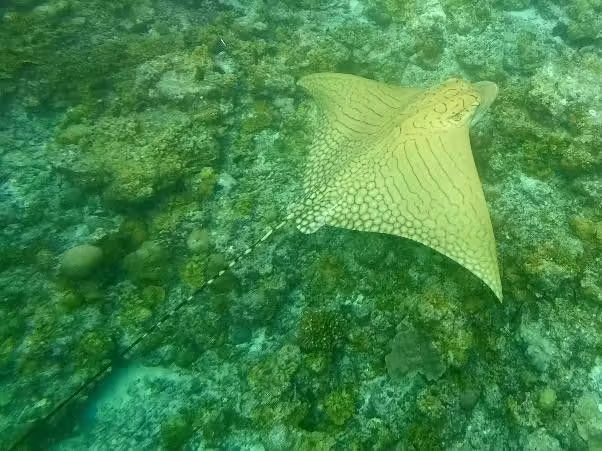On July 30th, guests snorkeling at OBLU NATURE Helengeli in the Maldives were witness to a rare and extraordinary encounter with one of the ocean’s most elusive species—the critically endangered Ornate Eagle Ray. While exploring the vibrant house reef just metres from the shoreline, a pair of snorkelers spotted the ray, a marine creature so rarely seen that only a few confirmed sightings occur globally each year.
Known as the “unicorn of the sea,” the Ornate Eagle Ray has had fewer than 60 verified sightings worldwide, despite inhabiting a wide range stretching from the Indian Ocean to the western Pacific. According to marine research organizations such as the BBC Wildlife, the Marine Megafauna Foundation, and Oceanographic Magazine, the species remains incredibly scarce. Classified as ‘Critically Endangered’ by the International Union for Conservation of Nature (IUCN), this ray faces ongoing population decline, and every confirmed sighting holds significant conservation value.
Greta Marcelli, Operations Manager of the TGI Maldives dive centre at Helengeli, described the encounter as a remarkable and rare occurrence for both the resort and marine science. “To have guests witness such a rare species so close to shore is truly exceptional,” she said. Marcelli also noted that similar sightings had occurred earlier this year at sister resorts OBLU SELECT Sangeli and OBLU XPERIENCE Ailafushi, both located in North Malé Atoll. In January, a staff member at Sangeli observed the ray in the island’s main boat lagoon, while a guest at Ailafushi captured a photo, perhaps unaware of the significance of the animal they had seen.
These sightings reinforce the importance of reef ecosystems like Helengeli’s, which provide shelter for even the most endangered marine species. Although rays have been protected under Maldivian law since 2014, monitoring of individual species remains limited. The rare appearance of the Ornate Eagle Ray highlights the urgent need for more targeted conservation efforts and habitat preservation.
Marine biologist Georgia Maggioni emphasized the ecological significance of such encounters, explaining that sightings of the Ornate Eagle Ray signal a healthy and thriving reef environment. “These reports are incredibly encouraging for our conservation work,” she said, adding that ongoing coral reef restoration around the resort’s shallow lagoons and deeper waters plays a key role in supporting biodiversity.
The IUCN, which maintains the Red List of Threatened Species, reported in 2023 that the Ornate Eagle Ray was documented only three times during a decade-long survey using remote underwater video across 391 coral reefs in 67 nations and territories. Two sightings occurred off Western Australia, and one in Palau, highlighting just how rare this species is in monitored marine ecosystems.
Very little is known about the migration patterns of the Ornate Eagle Ray due to its infrequent sightings. However, observations from locations such as the Maldives, Seychelles, Australia, and the Philippines suggest that the species moves across a wide Indo-Pacific range, possibly following seasonal shifts related to breeding or feeding. These rays tend to inhabit shallow, coral-rich coastal waters and sandy seabeds, indicating a preference for tropical reef environments.
Greta Marcelli concluded by noting the scientific importance of such rare encounters, especially for a species so poorly understood. “Each confirmed sighting provides critical data for understanding its range and behavior,” she said. “Thanks to our guests, we now have detailed imagery showing the ray’s unique back pattern, which we share with our marine biology partners to assist in tracking its movement and supporting global research.”



